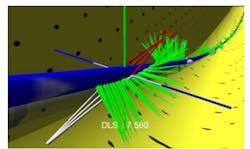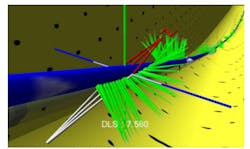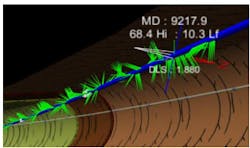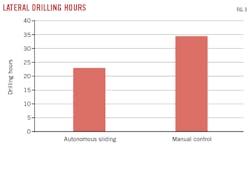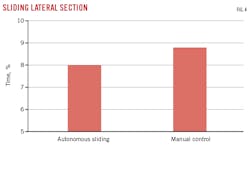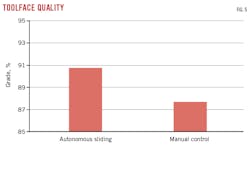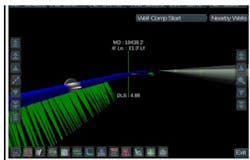Permian data show benefits of fully automated directional drilling
Bill Chmela
Michael Barrett
Motive Drilling Technologies
Dallas
Randy Goll
Motive Drilling Technologies
Oklahoma City
Jeremy Cantwell
Todd Benson
Motive Drilling Technologies
Dallas
Sarah Kern
Helmerich & Payne Inc.
Houston
Brian Alleman
Hunt Oil Co.
Dallas
Data from Permian basin drilling show the benefits of automation advances. Next-level drilling automation executes steering decisions from the bit guidance system automatically. Slide sequences are initiated, executed, and terminated by directly linking the bit guidance system with the rig’s existing control system.
This integrated system is coupled with oversight from expert directional drillers in a remote directional drilling command center. The collaboration between human and machine has resulted in lower drilling costs, lower lifting costs, and better hydrocarbon production potential.
Path to fully autonomous
Fully autonomous drilling can only be accomplished by machines performing all tasks in the drilling process currently performed by people, but without direct human control. Autonomous drilling, however, is not an all-or-nothing concept. On the path towards fully autonomous drilling, individual tasks can be automated while other tasks continue to be performed by humans. For instance, systems using mean squared error (MSE) calculations to automate control of drilling parameters while rotating have been in use and have added significant value to drilling operations for years. While these isolated systems enhance value, many drilling tasks remain in the hands of the drillers themselves.Autonomous directional drilling
Autonomous drilling is not a new concept. Automated systems are already adding value by optimizing and changing parameters in real-time. But current systems typically control the rig only, while rotating the pipe from the surface. When adjusting the path of the bit by sliding with traditional BHAs, the driller or directional driller typically takes over the manual process of drilling without automation. Precise orientation of the bit when sliding is a unique and valuable skill held by relatively few exceptional drillers and directional drillers.
Most wells drilled in unconventional plays use traditional BHAs due to their proven reliability and cost effectiveness. Fully autonomous drilling using these traditional BHAs, however, cannot be reached without automating two important directional drilling tasks: the start and stop depths of required slides, along with the correct orientation of the toolface and decisions to set and hold the toolface in the correct orientation while reacting to variations in formation and other subsurface parameters in real time.
Bit guidance
Significant progress was achieved by automating the first of these tasks with an autonomous bit guidance system configured with operator-defined guidelines. Successfully drilling over 800 wells in the major North American unconventional basins and on rigs operated by every major rig contractor is evidence of the system’s success. The bit guidance system goes well beyond traditional directional drilling methods by employing advanced computer algorithms to make steering decisions automatically, with more consistency, speed, and reliability than human directional drillers alone. The bit guidance system removes variability around the directional driller’s decision making and experience that leads to the significant variations in performance often seen today. Instead, the guidance system provides high levels of consistency and performance somewhat independent of the directional driller’s experience level by automating tasks best performed by a machine:
- Providing automated quality control and advanced survey calibration.
- Performing standard directional drilling calculations with more accuracy, more detail, and more speed than humanly possible.
- Enhancing analysis using real-time data streams.
- Advising the driller through step-by-step slide and rotate guidance.
Quality control and advanced survey calibration include automated correction for survey tool interference. It uses more accurate magnetic background models, further reducing uncertainty and improving accuracy.
Standard directional drilling calculations and reporting typically performed by directional drillers are now performed automatically, saving valuable time. This allows the directional driller to give his full attention to the current situation without distraction.
Data analysis is enhanced using real-time streams, and the system automatically provides the driller with step-by-step slide-rotate guidance by pairing dynamic data analysis with the operator’s parameters. Slide-rotate decisions are uniquely based upon the estimated costs to the operator associated with each decision. The financial impact of rig time, risk associated with tortuous wells, and potential loss of hydrocarbon production are factors in each decision.The bit guidance system uses edge computing installed at the wellsite. Directional drillers provide oversight of the guidance.
This human and machine collaboration leads to wells drilled with lower cost, lower risk, and greater hydrocarbon production potential. One directional driller can monitor multiple wells, saving personnel costs and making operations safer by reducing travel time and time on the rig floor.
For optimum performance, the system’s guidance must then be executed on the rig. A review of over 12 million ft drilled with the bit guidance system shows many instances in which the actions of the driller did not match guidance from the system. This inconsistency can be attributed to:
- Incorrect initial orientation of the tool.
- Inability to set and control the toolface from the start of the slide
- Driller difficulty maintaining a proper toolface orientation.
Each of these occurrences require experience and skills to remediate, whether realigning, setting, controlling, or holding the proper toolface orientation. Green spikes in Figs. 1-2 show toolface orientation during the slide sequences. A more consistent toolface orientation is displayed by a series of spikes extended in a straight line from the wellbore. Erratic spikes or a rotation of spikes indicate issues holding toolface.
In each of these cases, continual adjustments to drilling parameters require alertness, experience, and skills acquired over years of drilling in a specific basin. Drilling personnel possessing these traits are in high demand and often unavailable on all of an operator’s rigs, particularly during times of increasing rig count.
Autonomous sliding
An automated digital control module designed, fabricated, and introduced in the field augments drillers’ skills through automated proactive control of rig equipment while sliding. The system receives the instructions directly from the bit guidance system and executes the slides, continuously compensating for formation variability and for the effects of reactive torque.
The initial control module for deployment was designed to be integrated onto a fleet of super-spec rigs with uniform equipment, enabling the development, testing, upgrades, and crew training to be scaled consistently across a fleet of over 200 fully compatible rigs. These rigs include 7,500 psi mud pump systems, increased setback capacity for longer measured-depth wells, walking and skidding capabilities for larger pads, and digital platforms to facilitate autonomous drilling. The control module is also fully compatible with other automation systems deployed on these rigs. The system is being fine-tuned for continued autonomous directional drilling with these rigs in the Permian basin.
Field implementation
Results show that automated decision-making, together with automated machine control of sliding, can reduce drilling time, reduce slide percentage, and deliver a smoother, more accurate wellbore.
Results from wells drilled with the slide control module are compared with wells drilled without this automation. The wells were drilled in the Permian basin with the same rig, similar drilling parameters, and a comparable drilling environment, with the following well-program details:
- Upton County, Tex.
- Wolfcamp B formation.
- Bit: 8 ½-in. 5 blade, 5/8-in. polycrystalline diamond compact cutter.
- Motor: 6 ½-in. 7/8 lobe, 6.4 stage, 2° bend, 4.05 bit to bend.
- All surface locations within 3-mile radius.
- Lateral lengths of 10,300-10,700 ft.
- Total of eight wells drilled between October 2017 and June 2018.
When implemented, the automated slide module contributed to an average of 14% less time to drill the lateral section then the average of the wells drilled using manual control (Fig. 3). The primary reason for the reduction in drilling hours was a reduction in sliding percentage in the lateral section (Fig. 4), due to more precise toolface control. With sliding rates of penetration (ROP) much lower than rotating ROPs, reductions in slide percentage not only lead to a less tortuous well, but also directly lower costs by reducing drilling time.
Slide reductions can come from two sources: better identification of when to slide, and better execution of the slide. In the wells studied, the automated control module delivered a 3.4% increase in slide quality (Fig. 5).
The reduction in sliding also helps deliver wells with fewer doglegs. Application of autonomous sliding technology delivers factory-like precision to the slide process (Fig. 6).
Automated decision making
Expert directional drillers are in high demand. Design of the autonomous bit guidance and sliding systems provides consistency to operations and allows drillers with less experience to deliver consistent results. It was also found that even the performance of expert drillers can be improved, they too being overwhelmed by data at times.
Nobel Prize winning author Daniel Kahneman’s book ‘Thinking Fast and Slow’ presents numerous examples of situations where high performers and experts perform poorly during certain situations due to the way the human brain processes information. Kahneman explains that humans have two modes of thinking associated with decision-making:
- Mode 1 operates automatically and quickly, with little or no effort and no sense of voluntary control.
- Mode 2 allocates attention to the effortful mental activities that demand it, including complex computations.
Mode 1 describes how most directional drillers make decisions: quickly and intuitively. The best directional drillers also know when to shift to Mode 2, where effortful geometric computations must be performed while incorporating additional data.
Automation of individual tasks on the rig provides significant value to the operation without the need for full automation. The data show an already top performing rig improving its performance by combining the prior successes of automated directional drilling decision making with the ability to execute those decisions using an automated slide module. The combined system delivers both higher consistency and improved performance.
Acknowledgments
The authors would like to thank the Helmerich & Payne rig crew, the directional drillers in the command center, and Hunt Oil.
Bibliography
“A Motive for Better Drilling Decisions,” Innovoil, No. 50, Feb. 22, 2017.
Chmela, B., Barrett, M., and DeVerse, S., “Digitally Reducing Bit Steering Inaccuracies,” E&P Magazine, Aug. 1 2018.
Chmela, B., “Improved Directional Drilling Through Automation,” E&P Magazine, Apr. 3 2017.
Daugherty, P.R. and Wilson, J.H., ‘Human + Machine, Reimagining Work in the Age of AI,’ Harvard Business Review Press, 2018.
Kahneman, D., ‘Thinking Fast and Slow,’ Farrar, Straus, and Giroux, Oct. 25, 2011.
Rassenfoss, S., “Disruptive Drilling Technology Is All About Money and Those Who Have It,” Journal of Petroleum Technology, Oct. 9, 2017.
Rassenfoss, S., “SPE Annual Conference Highlights Sustainability, Disruptive Technologies,” Journal of Petroleum Technology, Dec. 1, 2017.
Rassenfoss, S., “Life is Complicated and Uncertain: Why Not Just Focus on Drilling Faster?” Journal of Petroleum Technology, Sept. 25, 2018.
Rassenfoss, S., “What Happens to Directional Drillers When Computers Are Directing Drillers?” Journal of Petroleum Technology, Aug. 1, 2017.
The authors
Bill Chmela, vice president, Motive Drilling Technologies, Dallas, Tex.
Michael Barrett, director of finance, Motive Drilling
Technologies, Dallas, Tex.
Randy Goll, command center operator, Motive Drilling
Technologies, Oklahoma City, Okla.
Jeremy Cantwell, command center analyst, Motive Drilling
Technologies, Dallas, Tex.
Todd Benson, president and chief executive officer, Motive
Drilling Technologies, Dallas, Tex.
Sarah Kern, marketing analyst, Helmerich & Payne Inc.,
Houston, Tex.
Brian Alleman, drilling engineer, Hunt Oil Co., Dallas, Tex.
Based on presentation to American Association of Drilling Engineers National Technical Conference and Exhibition, Denver, Apr. 9-10, 2019
